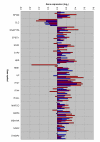Whole blood gene expression in infants with respiratory syncytial virus bronchiolitis
- PMID: 17166282
- PMCID: PMC1713240
- DOI: 10.1186/1471-2334-6-175
Whole blood gene expression in infants with respiratory syncytial virus bronchiolitis
Abstract
Background: Respiratory syncytial virus (RSV) is a major cause of viral bronchiolitis in infants worldwide, and environmental, viral and host factors are all of importance for disease susceptibility and severity. To study the systemic host response to this disease we used the microarray technology to measure mRNA gene expression levels in whole blood of five male infants hospitalised with acute RSV, subtype B, bronchiolitis versus five one year old male controls exposed to RSV during infancy without bronchiolitis. The gene expression levels were further evaluated in a new experiment using quantitative real-time polymerase chain reaction (QRT-PCR) both in the five infants selected for microarray and in 13 other infants hospitalised with the same disease.
Results: Among the 30 genes most differentially expressed by microarray nearly 50% were involved in immunological processes. We found the highly upregulated interferon, alpha-inducible protein 27 (IFI27) and the highly downregulated gene Charcot-Leyden crystal protein (CLC) to be the two most differentially expressed genes in the microarray study. When performing QRT-PCR on these genes IFI27 was upregulated in all but one infant, and CLC was downregulated in all 18 infants, and similar to that given by microarray.
Conclusion: The gene IFI27 is upregulated and the gene CLC is downregulated in whole blood of infants hospitalised with RSV, subtype B, bronchiolitis and is not reported before. More studies are needed to elucidate the specificity of these gene expressions in association with host response to this virus in bronchiolitis of moderate severity.
Figures


References
-
- Black CP. Systematic review of the biology and medical management of respiratory syncytial virus infection. Respir Care. 2003;48:209–231. - PubMed
MeSH terms
Substances
LinkOut - more resources
Full Text Sources
Other Literature Sources
Medical

